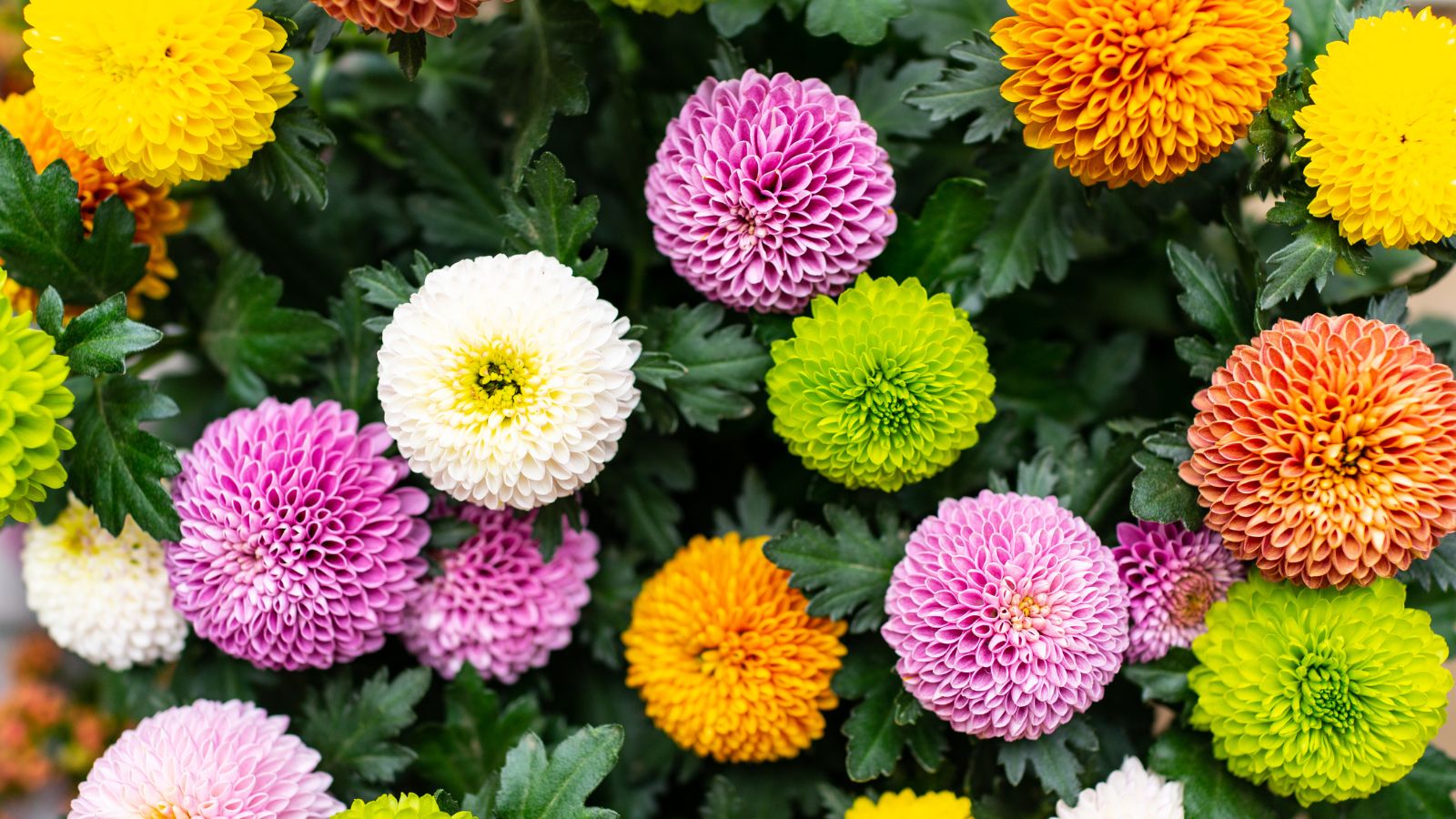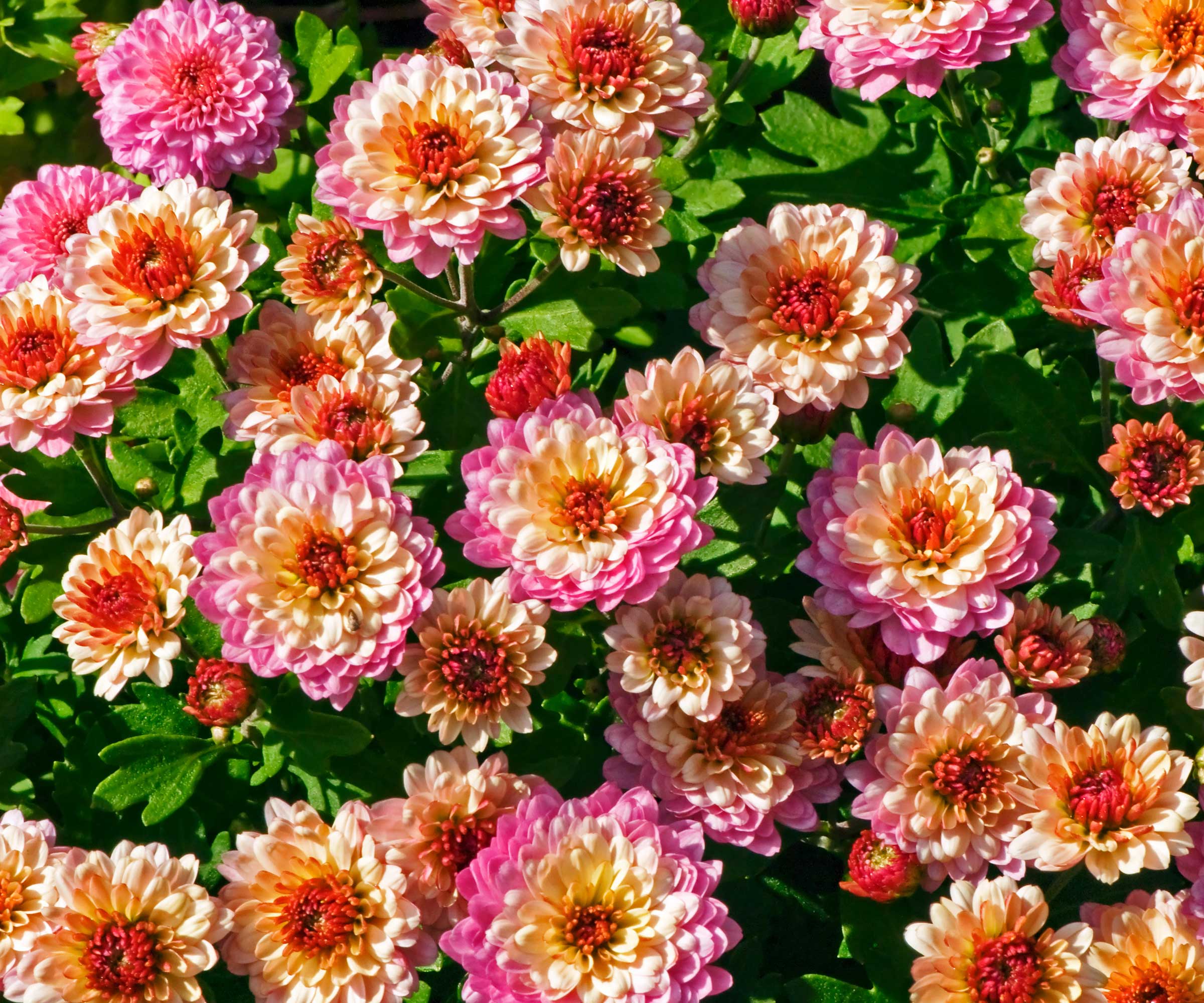
Mums, or chrysanthemums to give them their full name, are a favorite among gardeners, particularly during fall when their vibrant blooms bring life to your outdoor spaces. But as temperatures drop and frost becomes a concern, you may wonder can mums withstand frost, or if the cold signals the end of their beauty?
While mums are known for their ability to handle cooler weather, and some varieties can even survive light frosts, they aren’t fully frost-resistant. Their tolerance to cold spells depends on a range of factors including the variety, how well-established the plant is, and whether they are being protected.
We consulted with gardening experts who explained chrysanthemums' temperature tolerance, what affects their resilience, and how to protect plants from frost – including tips to winterize mums – helping to extend their lifespan through cold weather.
What is the temperature tolerance of mums?

Different extremities of frost and cold impact mums in various ways, depending on the temperature, the type of chrysanthemum, and how established the plant is.
In cases of light frost, when temperatures are around 30°F to 32°F, the upper parts of the plant – such as the flowers and leaves – may show signs of minor damage, wilting or slight discoloration, for example. However, the plant itself will usually cope, especially if it’s well-established and planted in the ground.
Once temperatures drop below 28°F, mums are at serious risk of damage, especially if the hard frost is prolonged. The flowers, foliage, and even stems may turn black and die as a result. Buds may freeze, preventing future blooming, and the plant can go dormant or even die if the roots aren’t protected.
Hardy perennial mums stand a better chance of surviving hard frost, but even they need to be properly prepared, particularly if the plant is still young or newly planted. Joe Gerrior, gardening expert and owner of Gerrior Masonry & Landscape warns: 'When temperatures threaten to dip below 28°F, protective measures become essential.'
Factors that influence cold tolerance of mums

Determining how well chrysanthemums can handle cold weather will help you better prepare and protect your plants. Their resistance is influenced by a number of characteristics, including the variety of mum and how established the roots are in the ground.
Type of mum: Some varieties of mums are more resilient, and how long chrysanthemums last will depend on the type and growing conditions.
Perennial mums, as their name suggests, are bred to survive multiple seasons, including winter, particularly in USDA hardiness zones 5 through 9. These hardy mums have stronger root systems and, if planted early enough in the season, can develop the resilience needed to withstand frost. While they are more resilient than other varieties, they nevertheless need specific conditions to withstand frost.
Annual mums, which are often sold as decorative plants, are more sensitive to the cold. These typically last for just one season and may not survive a frost unless carefully protected.
Root establishment: Mums that have been in the ground for an extended period have had the opportunity to develop strong, deep root systems, making them more resilient to cold weather.
In contrast, newly planted chrysanthemums are more vulnerable to frost damage since their roots are shallow and therefore lack adequate insulation.
If you're planting mums in the fall, it’s important to give them sufficient time to establish themselves – ideally at least six weeks before the first frost – so they’re better equipped to handle the cold.
How to protect mums during cold snaps

Properly preparing your chrysanthemums for colder weather can extend their lifespan. Consider these care strategies below to help them withstand frost and ensure they emerge vibrant and ready to bloom in spring.
1. Strategically plant or move mums
Strategic placement of your chrysanthemums can significantly enhance the plant's resilience to frost. If you have time to replant them in favorable spots before frost arrives, allowing the roots to establish, you can significantly boost their chances of survival.
Generally, mums planted in the ground or in garden beds will be a little more hardy because their roots can absorb warmth from the earth, compared to ones planted in pots. Joe Gerrior notes: ‘In zones 6 through 9, mums planted in the ground have a better chance of surviving because the soil keeps their roots insulated. They can usually handle temperatures down to around 20°F.'
'Potted mums are more vulnerable to the effects of frost, as their roots are more exposed,' warns Tom Monson, owner of Monson Lawn and Landscaping. 'If frost is on the way, bring them indoors on colder nights to make certain that they aren’t damaged, and you can enjoy their blooms as long as possible before winter sets in.'
Another useful tactic is leveraging natural features for protection.
Placing mums closer to walls or using natural windbreakers can make a big difference. 'Positioning mums next to structures or terrain that retains heat can provide a microclimate that moderates temperature fluctuations,‘ explains Josh Payne, owner of Classic Landscapes.
For example, the surfaces of south-facing walls and large rocks absorb sunlight during the day and release it at night. Placing mums near these allows them to benefit from retained warmth, helping to protect the plants from cold nighttime temperatures.
2. Use mulching to insulate roots
‘Several inches of mulching around the base of mums helps insulate roots from freezing temperatures as a layer of mulch or boughs acts like a natural blanket against ground frost,' says Pete Marsh, gardening expert and founder of Blue Oak Patio and Landscape.
'The mulch, along with the plant’s foliage, creates a microclimate around the plant that is a few degrees warmer than the air.'
The best mulches for mums are airy and light, such as clean, weed-free straw, pine needles, or shredded hardwood. Opt for organic mulch, such as this Organic Mechanics hardwood bark mulch from Walmart, ensuring you create a layer that is at least two to three inches deep to create a buffer against temperature swings.
3. Cover mums to protect from frost
‘To protect mums from frost, we advise covering them with frost protection cloth, also known as row cover,' says Pete Marsh. We recommend this frost cover, from Amazon. 'This lightweight, breathable fabric can protect plants down to 25°F.
Pete continues, 'For colder temperatures, a heavier material like burlap can be used.' Alternatively, positioning straw bales around the plants to create a frost barrier.
'The covering should be placed over plants in the evening before frost is expected and removed the following morning after temperatures have risen above freezing.
4. Ensure proper drainage
The type of soil your mums are planted in can significantly impact their vulnerability to frost damage. Poor drainage can intensify the effects of frost, as excess water in the soil can freeze around the roots when temperatures drop, increasing the risk of frost damage and root rot.
To avoid this, plant your mums in soil with good drainage. Loose, aerated soil helps excess moisture drain away more efficiently, preventing the roots from sitting in water during cold snaps. This Miracle-Gro Potting Mix is a best seller at Walmart.
If your mums are planted in a garden bed, consider raising the bed slightly to improve drainage. Joe Dogherty, owner at D&G Landscaping suggests: ‘I recommend elevating potted mums on wooden planks during colder months. This helps improve drainage and protects roots from frost, allowing their blooms to last well into late autumn.’
We recommend using a soil moisture meter, such as this one from Amazon, to monitor the effectiveness of soil drainage and make adjustments where necessary.
FAQs
What post-frost care can keep mums healthy?
After a frost hits, proper aftercare is crucial to help your chrysanthemums recover and thrive.
One key question gardeners often ask is, should you deadhead chrysanthemums after frost damage? The answer is yes – removing damaged areas prevents the plant from wasting energy trying to heal dying tissue, allowing it to focus on the healthy parts instead.
Use clean, sharp pruning shears, such as theseDeli Garden shears from Walmart, to remove any frost-damaged parts of the plant. This includes dead flowers, blackened leaves, and any stems that have turned mushy or brittle. Trim back to a healthy part of the plant to encourage new growth.
However, it’s important not to prune too aggressively right after frost damage. For perennial mums, resist the urge to cut the plant all the way back, as new growth might still emerge from the base or roots.
Remember, mums can sometimes look more damaged than they are after a frost, but as long as the roots and base of the plant remain healthy, they may bounce back with some care and time.
What are the ideal growing conditions for mums?
Mums are well-suited for cooler weather, which is why they're a popular choice for fall gardens. However, like most plants, they have specific temperature ranges where they thrive best.
They prefer sunny days and cooler nights, which stimulate flowering and help the blooms last longer. The ideal temperatures to grow chrysanthemums is between 60°F and 70°F.
‘With the proper precautions taken, most mum varieties can continue flowering into late fall even with some light frost,' explains Pete Marsh. 'However, for best results, choose cultivars bred specifically for cold hardiness in your area.
'For example, our favorites for central Ohio are the ‘Hardy Red’ and ‘Clara Curtis’ varieties.’







